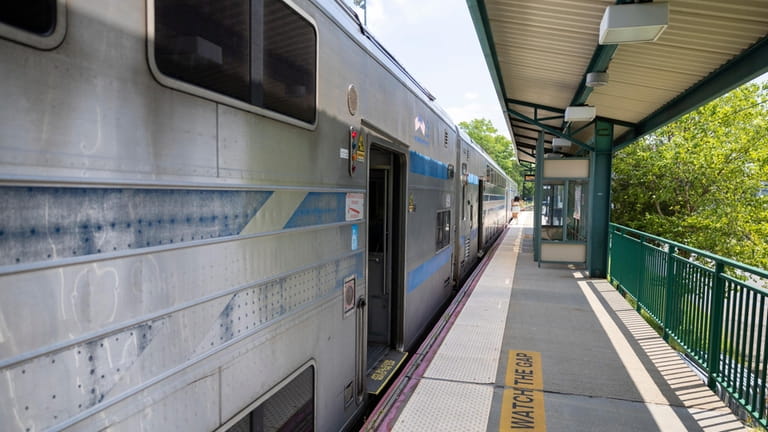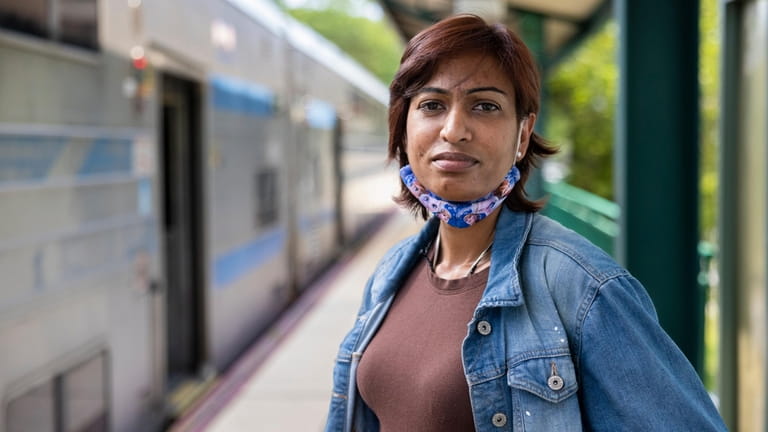LIRR shelves battery power, cites cost, reliability issues

Battery-operated train technology, which the LIRR hoped would revolutionize how it operates nonelectrified tracks, has turned out to be too costly, inconvenient and risky to implement any time soon, the railroad said.
Long Island Rail Road officials said last month that they would not move forward with the next phase of testing the battery trains, citing costs as one of the main reasons. After a feasibility study, the railroad determined it would cost $26 million to outfit two electric train cars — significantly more than the cost of buying a pair of new train cars. The LIRR’s new M9 fleet cost about $3.6 million per car.
The setback comes as the LIRR faces growing pressure from riders, elected officials and conservationists to modernize its diesel territory, where trains are fewer in number, less reliable, and less environmentally friendly than the rest of the LIRR’s fleet. Diesels compose about 14% of the LIRR’s 1,251 train cars.
LIRR officials said they hope the technology still could be part of the railroad’s future.
WHAT TO KNOW
- The LIRR has decided not to go ahead with the next phase in its tests of "battery electric multiple units," which would have allowed trains to operate on third-rail power, where available, then switch to battery power where it's not.
- An $860,000 feasibility study with train manufacturer Alstom raised several concerns, including over the price of retrofitting train cars with batteries — $26 million per pair — and over the need to remove seats from cars to make space for the technology.
- LIRR officials said they are not giving up on the technology, and could incorporate it into the design of its next generation of train cars, the M9A, which remains several years away.
“There’s a lot of optimism about this. We want this to work,” said Rob Free, the LIRR's senior vice president of operations. “We continue to look to see if it’s possible down the road.”
Gerard Bringmann, chairman of the LIRR Commuter Council — the railroad’s state-regulated rider advocacy group — called the findings of the feasibility study “a delay, not a defeat.”
“It could happen 10 years from now,” said Bringmann, who travels on the Port Jefferson branch, which relies on diesel trains because tracks are not electrified. “It may well be the next great innovation. I’m optimistic about it. But I’m realistic about the time frame.”
The railroad, which spent $860,000 on the eight-month feasibility study, had hoped to take the next step by operating a test train this year on its Oyster Bay line — the shortest of the LIRR’s nonelectrified branches. But the railroad, after conferring with an outside consultant, made the call to pull the plug on the pilot program before it got that far, based on the findings of the feasibility study.
The pilot program was announced in April 2021 by then-LIRR president Phillip Eng, who said the railroad’s partnership with French train manufacturer Alstom to test the technology would be “a total game changer” and “quantum leap toward the future.” If the technology panned out, the LIRR would be the first commuter railroad in the United States to operate commuter trains on battery power, officials said.
The mechanics were modeled after "battery electric multiple unit" train technology already in place in other parts of the world. Alstom and the LIRR aimed to retrofit existing “M7” electric train cars with lithium batteries that would have the trains run on third-rail power, where available, then seamlessly switch to battery power where it’s not. Charging stations located at the end of branches would re-energize train batteries between runs.
But the feasibility study found unexpected expenses, including, potentially, having to build additional electrical substations to provide the railroad system with enough juice to charge the trains, while also powering the third rail, officials said.
There were other sticking points in the feasibility study, including space issues.
Making space for the compartment that would house the batteries inside the 20-year-old train cars would have required removing nine seats per car, and could have contributed to crowding conditions amid ongoing COVID-19 concerns. And, if the LIRR ultimately decided not to go forward with the battery trains, it would have had to remove the batteries and put the seats back, at its own cost.
There also was the question of whether the technology would work.
Although Alstom provided assurances that the batteries could last long enough for a train to cover the 13-mile stretch of nonelectrified tracks on the Oyster Bay line, railroad operations officials remained concerned that, if a train was unexpectedly delayed, it could run out of power before reaching its destination and strand passengers on board.

The LIRR has decided not to go forward with a pilot plan to test a battery-operated train on its Oyster Bay line. Credit: Corey Sipkin
Also, charging the trains between runs meant they would not be available for service — depleting the LIRR’s already-stretched electric fleet. The LIRR has said it will need to bring back 100 of its 1980s-era M3 cars to have enough trains for the launch of its East Side Access service to Grand Central Terminal in December.
For all those reasons, the LIRR pulled back on moving into phase two of the program.
“Not every feasibility study leads to feasibility,” Aaron Donovan, spokesperson the Metropolitan Transportation Authority, the LIRR’s parent organization, said in a statement. “In this case, we established a two-phased pilot so the first phase could lead us to understand whether a second phase was worthwhile. It was determined it wasn’t due to the costs of retrofitting existing cars.”
Railway Age magazine editor-in-chief William Vantuono, who followed the LIRR’s testing of the battery technology, said he was “not surprised” that it ultimately wasn’t ready for rollout.
“The technology is unproven in heavy, commuter rail service. And you know how the Long Island Rail Road operates. It’s like an oversized subway. It’s one train after the other,” said Vantuono, who expects the LIRR to wait for another railroad to adopt the technology on new trains before taking its next step with the “very experimental” battery technology.
Alston spokesperson Clifford Cole said in a statement that the company continues “to work and engage with agencies and operators, including [the] LIRR, to explore the application of new technologies that can optimize and increase the sustainability of their operations."
The LIRR had hoped that operating battery trains even on just one branch of its system could make a big difference — by improving service on that line, freeing up diesel cars to boost service in other parts of the system, and reducing the railroad's carbon footprint.
A letter from a coalition of Long Island business and conservation groups to state climate leaders last month urged them to require the LIRR to eliminate its diesels, and electrify its entire system, as part of the state’s goal to become carbon neutral by 2050.
"While the news regarding battery trains is disappointing, the NYS Climate Act deadlines are not budging," said one of the letter's authors, Kyle Strober, executive director of the Association for a Better Long Island, an economic development group. "The need for electrification to meet the state's green mandates appears even more urgent."
The MTA has said it is considering further electrification as part of its forthcoming “Twenty Year Needs Assessment,” which would guide future infrastructure spending. But MTA officials have cautioned that electrifying tracks could be cost prohibitive and require building on private property.
LIRR officials emphasized that battery-operated trains could still be in their future, including as part of the design of some cars in their next generation of trains, the M9A. The first of those trains aren’t expected to arrive until 2027.

Oyster Bay commuter Sati Badree. Credit: Corey Sipkin
Oyster Bay commuter Sati Badree said she will continue to deal with fewer trains and more frequent transfers.
"We practically have to wait a good couple of hours before we get another train. We shouldn’t have to, but that’s how it is," said Badree, while waiting at her station platform for the next train to Jamaica on Thursday morning. "It is very bad … But we don’t have a choice, especially if you don’t have transportation for yourself, like if you don’t drive.”
Meanwhile, other railroads in the United States are moving ahead with their own studies of battery-operated trains, including Boston’s Massachusetts Bay Transportation Authority, which is considering electrifying parts of its system, and having trains run on batteries in the small gaps where electrification is not feasible. The agency already has met with several potential manufacturers and said it could be running on battery power in five years.
Testing barrels found in Bethpage ... Opening statements in Trump trial ... Jets trade Zach Wilson ... Tulip festival
Testing barrels found in Bethpage ... Opening statements in Trump trial ... Jets trade Zach Wilson ... Tulip festival

